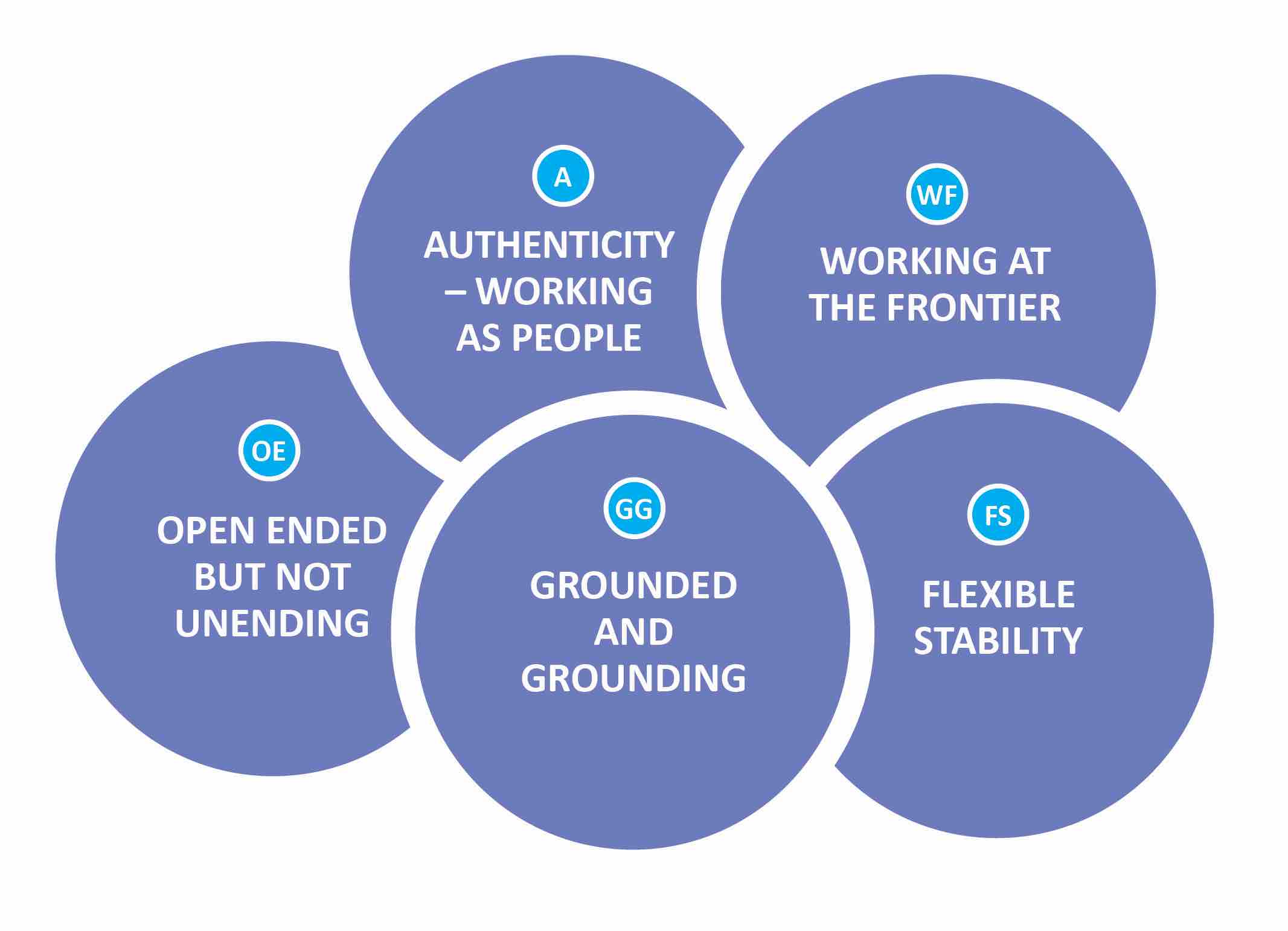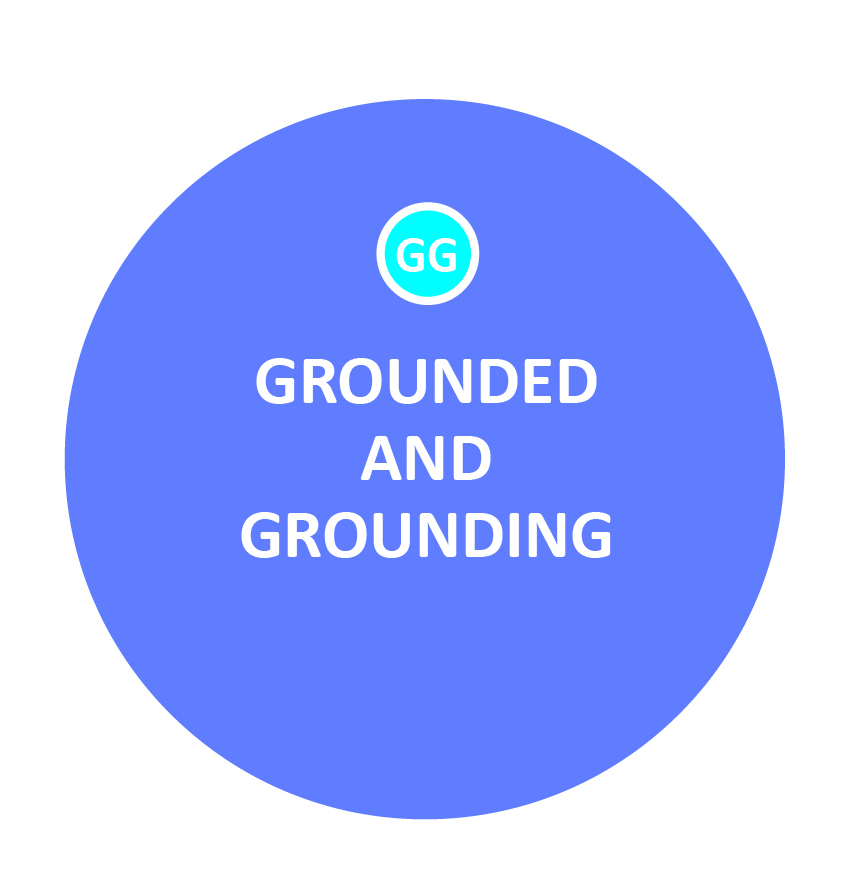what are the characteristics of impactful partnership?
You can download these resources and the worksheet as a separate file here (the link is provided again below).
The second aspect of the essence of partnership focuses on characteristics of impactful work with families. The study findings show that impactful partnership have five characteristics: working at the frontier; flexible stability; being grounding and grounded; being open-ended but not unending; and authenticity, which means working with as people, not as problems.
Five overlapping characteristics of impactful partnership
Open-ended but not unending
Not leaving families falling off a cliff or reaching a dead end
working as people
Being authentic and who you are, not what you are
at the frontier
Innovating, improvising, going with the flow, going beyond
Dynamic balance between standard and emergent practices
Grounded and grounding
In the here and now, addressing what is happening
Key concept: open-ended but not unending
As intimate outsiders in family life, helpers always enter relationships knowing there will be an end. However, it is important to avoid endings that feel abrupt or unexpected to families. Being open-ended means giving a sense that the relationship can go where it needs to or connect with others when it finishes. Being unending means that it is working towards an inevitable closure of some kind.
at the frontier
Working at the frontier means being creative and flexible, going outside the box when needed to support families
Working at the frontier means being in unfamiliar situations or charting new territory and often results in encountering the unexpected. This kind of work is done through innovating, improvising, flexible logistics, going with the flow, and going just beyond what is normal or routine. Working at the frontier connects with the idea of partnership as an evolving art.
The study findings show that impactful partnership work is often at the frontier in one or more ways. Sometimes ‘going where you need to go’ can mean going just ahead of policies, procedures and systems; this needs to be done in a considered manner and guided by what is in a family’s or child’s best interests, and weighed against any risks to helpers. Open communication with colleagues, managers and supervisors about this kind of work is important.
Living partnership practices explains how work at the frontier is done.
flexible stability
Flexible stability means being able to shift between two seemingly opposite capacities as the need arises
The project data showed that where lasting positive change happened, the partnership combined consistency and predictability on the one hand with agility and responsiveness on the other. This is flexible stability.
Parents need those helping them to be consistent and predictable, so that the relationship feels solid and secure.
However, impactful partnership also requires helpers to be sensitive, agile and responsive. Conditions of flexible stability are critical. Pacing and timing are key parts of this – being flexible to work at a pace that is best for parents, and to change this as parents’ needs change, but also offering stability by avoiding long or unplanned breaks without contact.
Consistency and predictability have to be balanced with creativity and agility.
Helpers need to treat all clients with the same respect and empathy, but they also need to match their approach to parents’ specific needs and preferences.
Clear responsibilities help both parties navigate change together, but roles have to be fluid and adaptable to circumstances.
Parents often need helpers to be reliably present and available, but also need to be given their own space from time to time.
Partnership work has to be stable in its positive orientation, based on families’ strengths and with purpose towards desired outcomes. It also needs honesty about struggle and difficulty.
“I can go on a home visit and I’ve got my agenda. Okay, today we’re going to talk about Max’s play skills. I’d get there and Tessa’s like oh my god, I didn’t get paid by Centrelink – all right, well, let’s do that.” (Helper)
Families need to feel that those supporting them are always on their side, but this cannot rule out helpers being ready to challenge parents and raise things they may find hard to hear.
It can help to build trust and secure parents’ commitment to change if the help they get is consistent and predictable. However, impactful partnership often requires creative work and agile practice.
The ways of being section describes dual ways of being together that connect with the characteristic of flexible stability.
grounded and grounding
Being grounded means being able to meet families where they are, and being grounding means helping them focus on the here and now
Impactful partnership work has to be grounded in and interact with what is happening for families and can mean helpers actually getting involved, for example, by joining children in play, or assisting parents while they settle a child or respond to a toddler tantrum. It also has to be grounding – helping families respond to and shape their everyday experiences.
Being on the ground with parents, and helping them feel grounded are complementary aspects of partnership that involve thinking about possibilities for change.
These characteristics are accomplished in a number of ways. Those in a supporting role can help bring families into a focus on the here and now, particularly when the future is scary for them.
Groundedness also comes from meeting parents where they are in the moment. This can mean getting down onto the floor with them during play, having a coffee together, or pausing to listen when parents need to get something off their chest.
Families trust others when they feel helpers are walking alongside them through change. Remembering details, being contactable when needed, and talking about a journey taken together all help to achieve this.
open-ended but not unending
While particular relationships may finish, the door is not shut on families. Where the relationship will lead is not fixed from the start.
We found that lasting positive change often depended on the partnership with families being open-ended but not unending. This is connected with the ways in which helpers were intimate outsiders in family life – sharing many difficult things, but never becoming part of the family.
Parents’ readiness to invest in a relationship and to take on challenge can be compromised if they see the pathway of support as short, or if they fear it may end abruptly and unexpectedly.
Services can sometimes offer indefinite timeframes, or at least have a long ‘tail-end’. When this is not possible, parents need to be assured that help won’t disappear just because they have used up what a particular service offers. However, there is always the intention that the relationship ends in some way. This is why partnerships are open-ended, but not unending.
There can be multiple forms of ending in the course of a relationship between a helper and family - their work together may transition from one focus to another, or the relationship may shift gear.
Being open-ended means the door doesn’t close suddenly on parents.
One early parenting group made effective use of social media to address this. While the group focused on the first 12 weeks of a child’s life, parents made lasting connections and continued to support each other for months afterwards.
“We have this Facebook page that’s fabulous and I think that should almost be a formal part of it, within that twelve week cycle, it should be set up and off you go, so you get a seamless transition.” (Parent)
This characteristic also means making sure the door doesn’t close suddenly on parents. Sometimes parents may overstep the mark in a relationship with a helper, or miss appointments or be unable to take agreed actions. The condition of open-endedness means support remains available, without judgement, when parents are able to ask for it again.
authenticity - working as people
This means working with families as people, not as problems to resolve, respecting who they are, their special knowledge, and their needs
Parents, professionals and volunteers all described the importance of working with each other as people – being real, not being a number. One parent described this as ‘working on my level’. Being authentic as an intimate outsider in family life is a key challenge for helpers.
Engaging with who people are, not what they are, avoids clients feeling they are defined in terms of their problems, and helps to ensure a holistic approach.
When one parent mentioned star signs as important, the nurse helping her said, ‘I’m a Capricorn, what are you?’ This showed care for what mattered to the mother.
Helpers remembering small details, or remembering families when they move between services or come back after a break (practice memory) allowed parents to feel they were being treated as people.
Authenticity is also accomplished through respectful communication. This acknowledges parents’ doubts and concerns as legitimate, but avoids confirming their sense of inadequacy. For example, when one mother said she didn’t know what her child wanted when she was crying, the nurse replied, ‘It’s good to wonder about these things, isn’t it?’
Back to top | Back to essence of partnership overview | Previous - Ingredients | Next - Ways of being
Using the characteristics to enhance your practice
The main worksheet is designed for practitioners to reflect on their practice. There is also a version that you may find helpful to use in your actual work with families - this contains the main figure and some key prompts.
Worksheet 2 (to print on A4 and complete by hand)
Combined resource and worksheet (can be completed in the digital file)







